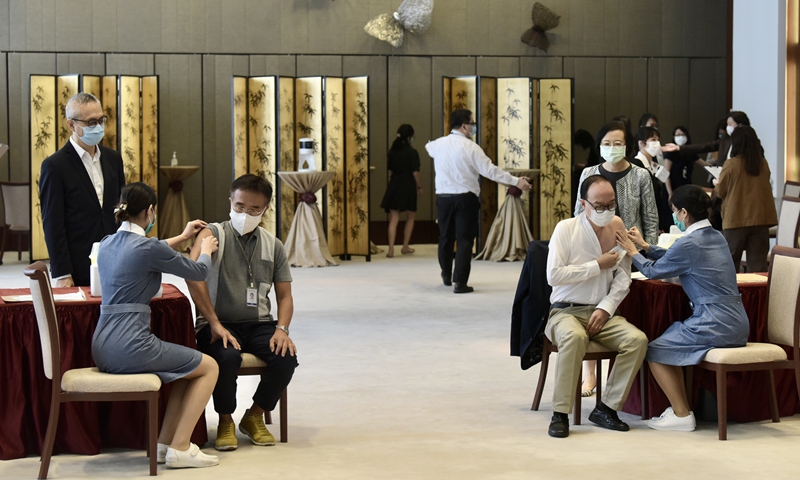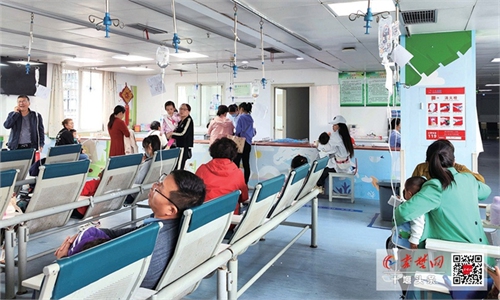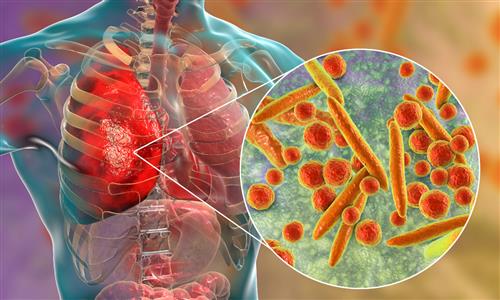China enters peak season for respiratory diseases; multiple places remind public to wear masks

Members of the Legislative Council of the Hong Kong Special Administrative Region (HKSAR) get their seasonal influenza vaccinations on Wednesday. The HKSAR government has reminded citizens to get vaccinated as soon as possible and to take personal health precautions. Photo: CNS Photo
From south to north, respiratory diseases have progressed to their peak period of incidence across China, posing a great threat to vulnerable groups such as children and the elderly with a rising risk of mixed diseases functioning together. Experts and local health authorities have issued reminders for people to wear masks but also assured the public there was no need to panic.
The number of patient visits to outpatient and emergency departments at hospitals has been increasing across the country in recent days, with the majority of the patients being children. Some adults, especially the elderly, are also among the patients.
Apart from mycoplasma pneumoniae pneumonia (MPP), influenza, and COVID-19, which the public is familiar with, there have also been a rise in bacterial and norovirus infections.
Liu Youning, a professor of epidemiology and respiratory medicine at the Chinese PLA General Hospital, told the Global Times on Thursday that autumn and winter are the high incidence seasons for infectious respiratory diseases in most parts of China.
In terms of infection rates, viruses are the most contagious, followed by atypical pathogens such as mycoplasma, chlamydia and legionella that are infectious but not as contagious as viruses, while most common bacterial infections are not contagious, according to Liu.
Experts warned that it is necessary to stay alert to the co-infection of mycoplasma pneumoniae and adenovirus, streptococcus pneumoniae and other pathogens that cause respiratory infection.
According to the statistics the Chinese National Influenza Center released on October 26, between October 16 and 22, the positive rate of influenza virus detected in southern provinces continued to rise, with the influenza type A virus (H3N2) as the prevailing virus. Meanwhile, influenza activity in some northern provinces also saw a slight increase.
Experts noted that influenza will also prevail in northern areas in one or two months.
According to Wang Dayan, director of the Chinese National Influenza Center of the National Institute for Viral Disease Control and Prevention, China CDC, influenza in China remains at a middle or low level but with a rising trend.
According to Gao Fu, an academician of the Chinese Academy of Sciences (CAS), since September, the level of influenza infections has been steadily rising. According to survey data from late October, the positive rate for influenza has reached 8.9 percent, and it is expected to gradually extend to the flu season in the near future.
Since influenza rates have been on the rise in multiple places across the country, the local health authorities in multiple places, including Changchun in Northeast China's Jilin Province, Handan in North China's Hebei Province, and Xiamen in East China's Fujian Province, have issued reminders to local residents to promptly take preventive measures, as there is a risk of interaction or co-prevalence of respiratory infectious diseases in China between this coming winter and next spring.
The Health Commission of Guangdong Province said on its official WeChat account on October 23 that according to the statistics by the Guangdong Provincial Center for Disease Control and Prevention, the level of influenza infections in Guangdong has increased recently, with the prevailing strain this time being influenza type A (H3N2). The health authority reminded local residents to take precautions in a timely manner.
The Jiangsu Commission of Heath announced on October 27 that 8,194 influenza cases were reported in East China's Jiangsu Province in September.
Usually, influenza is the most prevailing pathogen that causes respiratory diseases during autumn and winter with the majority of patients only showing symptoms of upper respiratory tract infection instead of pneumonia symptoms, Liu said.
Although COVID-19 still exists and is still spreading, it does not cause severe cases or lead to many deaths. Most of the current COVID-19 patients don't show pneumonia symptoms. In fact, only 8 percent show pneumonia symptoms, Liu added.
However, with the high incident of MPP this year, the public has been concerned about the superimposed impacts of influenza and MPP. According to Zhao Wei, director of the biosecurity research center at the School of Public Health of Southern Medical University, MPP can weaken the immune system, increasing the likelihood of secondary infections by other microorganisms. If it coincides with the spread of influenza, there is a possibility of the two mutually exacerbating the situation, Changjiang Daily reported.
Over the past month, MPP has become the disease of most concern among the public. However, although MPP is also a contagious disease that can cause cluster infections, it mainly prevails among adolescents and the symptoms of the disease are not severe. There are very few cases of respiratory failure or death cases caused by the disease, Liu said.
Lu Hongzhou, director of The Third People's Hospital of Shenzhen, told the Global Times on Thursday that MPP mainly prevails among children aged 5 or above. It is distinguished from other pneumonia mainly through pathogenic detection.
According to Lu, MPP has a relatively high incidence in China, accounting for 10 to 40 percent of community-acquired pneumonia among children. Infection of the disease can occur throughout the year, with a higher incidence in winter in northern China and in summer and autumn in southern China. Outbreaks often occur in densely populated environments such as schools, university dormitories, military camps and hospitals. However, MPP has not been designated as an infectious disease for statutory surveillance at present.
According to Lu, vaccination is the best method of preventing and controlling the spread of infections and multiple vaccines for human MPP are still in the research and development stage.


